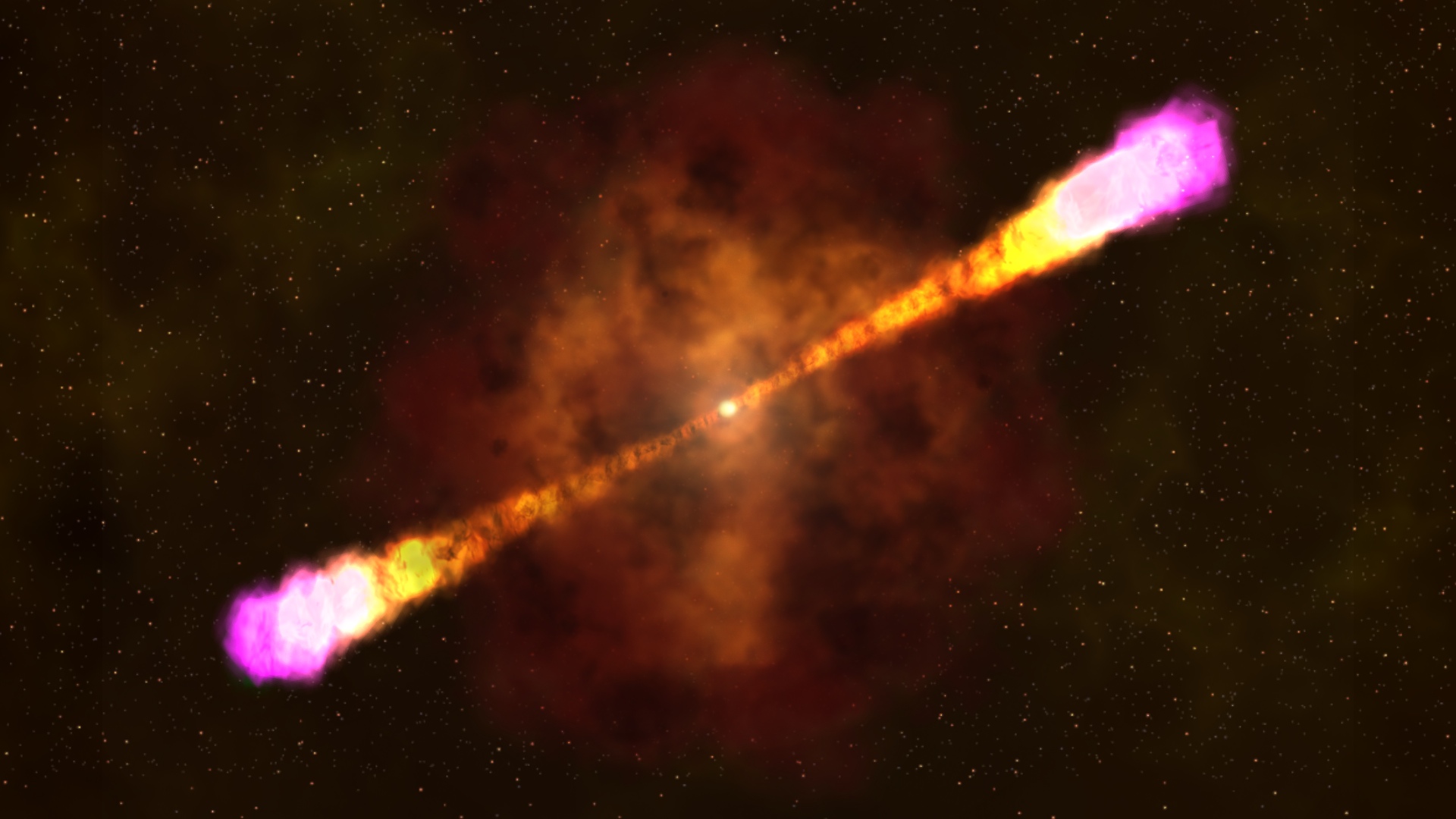|
GRB 160625B
GRB 160625B was a bright gamma-ray burst (GRB) detected by NASA's Fermi Gamma-ray Space Telescope on 25 June 2016 and, three minutes later, by the Large Area Telescope. This was followed by a bright prompt optical flash, during which variable linear polarization was measured. This was the first time that these observations were made when the GRB was still bright and active. The source of the GRB was a possible black hole, within the Delphinus constellation, about 9 billion light-years (light travel distance) away (a redshift of z = 1.406). See also * List of gamma ray bursts * Swift Gamma-Ray Burst Mission * Ultra-Fast Flash Observatory Pathfinder References External links GRB 160625B– NASA/IPAC Extragalactic Database (NED) GRB 160625B– Max Planck Institute for Extraterrestrial Physics The Max Planck Institute for Extraterrestrial Physics is a Max Planck Institute, located in Garching, near Munich, Germany. In 1991 the Max Planck Institute for Physics and Astrophy ... [...More Info...] [...Related Items...] OR: [Wikipedia] [Google] [Baidu] |
Gamma-ray Burst
In gamma-ray astronomy, gamma-ray bursts (GRBs) are immensely energetic explosions that have been observed in distant galaxies. They are the most energetic and luminous electromagnetic events since the Big Bang. Bursts can last from ten milliseconds to several hours. After an initial flash of gamma rays, a longer-lived "afterglow" is usually emitted at longer wavelengths (X-ray, ultraviolet, optical, infrared, microwave and radio). The intense radiation of most observed GRBs is thought to be released during a supernova or superluminous supernova as a high-mass star implodes to form a neutron star or a black hole. A subclass of GRBs appear to originate from the merger of binary neutron stars. The sources of most GRBs are billions of light years away from Earth, implying that the explosions are both extremely energetic (a typical burst releases as much energy in a few seconds as the Sun will in its entire 10-billion-year lifetime) and extremely rare (a few per galaxy per milli ... [...More Info...] [...Related Items...] OR: [Wikipedia] [Google] [Baidu] |
Light Travel Distance
Distance measures are used in physical cosmology to give a natural notion of the distance between two objects or events in the universe. They are often used to tie some ''observable'' quantity (such as the luminosity of a distant quasar, the redshift of a distant galaxy, or the angular size of the acoustic peaks in the cosmic microwave background (CMB) power spectrum) to another quantity that is not ''directly'' observable, but is more convenient for calculations (such as the comoving coordinates of the quasar, galaxy, etc.). The distance measures discussed here all reduce to the common notion of Euclidean distance at low redshift. In accord with our present understanding of cosmology, these measures are calculated within the context of general relativity, where the Friedmann–Lemaître–Robertson–Walker solution is used to describe the universe. Overview There are a few different definitions of "distance" in cosmology which are all asymptotic one to another for sma ... [...More Info...] [...Related Items...] OR: [Wikipedia] [Google] [Baidu] |
NASA/IPAC Extragalactic Database
The NASA/IPAC Extragalactic Database (NED) is an online astronomical database for astronomers that collates and cross-correlates astronomical information on extragalactic objects (galaxies, quasars, radio, x-ray and infrared sources, etc.). NED was created in the late 1980s by two Pasadena astronomers, George Helou and Barry F. Madore. NED is funded by NASA and is operated by the Infrared Processing and Analysis Center (IPAC) on the campus of the California Institute of Technology, under contract with NASA. NED is built around a master list of extragalactic objects for which cross-identifications of names have been established, accurate positions and redshifts entered to the extent possible, and some basic data collected. Bibliographic references relevant to individual objects have been compiled, and abstracts of extragalactic interest are kept on line. Detailed and referenced photometry, position, and redshift data, have been taken from large compilations and from the literature. N ... [...More Info...] [...Related Items...] OR: [Wikipedia] [Google] [Baidu] |
Ultra-Fast Flash Observatory Pathfinder
The Ultra-Fast Flash Observatory (UFFO) Pathfinder is a space observatory measuring prompt emission of gamma-ray bursts (GRB) both in optical/UV and in X-ray range down to sub-second timescales for the first time. Instead of turning the whole satellite towards GRB location like the Swift Gamma-Ray Burst Mission (that takes about 100 seconds), UFFO employs a slewing mirror telescope approach – the optical path of the telescope is changed by rotation of motorized mirror within ~1 second after burst was detected. UFFO was launched April 28, 2016 on board the Mikhailo Lomonosov satellite during the first launch from the new Russian Vostochny Cosmodrome. Instruments UFFO Burst Alert & Trigger telescope (UBAT) UBAT is a wide-field coded mask X-ray camera. It has a 191 cm2 detecting area, 90.2°×90.2° field of view and is sensitive in the 15-150 keV photon energy range. UBAT is able to localize bursts with an accuracy of 7σ to a region 10 arcmin across in less than one seco ... [...More Info...] [...Related Items...] OR: [Wikipedia] [Google] [Baidu] |
Swift Gamma-Ray Burst Mission
Neil Gehrels Swift Observatory, previously called the Swift Gamma-Ray Burst Explorer, is a NASA three-telescope space observatory for studying gamma-ray bursts (GRBs) and monitoring the afterglow in X-ray, and UV/Visible light at the location of a burst. It was launched on 20 November 2004, aboard a Delta II launch vehicle. Headed by principal investigator Neil Gehrels until his death in February 2017, the mission was developed in a joint partnership between Goddard Space Flight Center (GSFC) and an international consortium from the United States, United Kingdom, and Italy. The mission is operated by Pennsylvania State University as part of NASA's Medium Explorer program (MIDEX). The burst detection rate is 100 per year, with a sensitivity ~3 times fainter than the BATSE detector aboard the Compton Gamma Ray Observatory. The Swift mission was launched with a nominal on-orbit lifetime of two years. Swift is a NASA MIDEX (medium-class Explorer) mission. It was the third to be lau ... [...More Info...] [...Related Items...] OR: [Wikipedia] [Google] [Baidu] |
List Of Gamma Ray Bursts
The following is a list of significant gamma-ray bursts (GRBs) listed in chronological order. GRBs are named after the date on which they were detected: the first two numbers correspond to the year, the second two numbers to the month, and the last two numbers to the day. List Extremes Firsts Most distant GRB Notes Footnotes References * * * * * * * * * * * Citations {{reflist See also * Lists of astronomical objects This is a list of lists, grouped by type of astronomical object. Solar System * List of Solar System objects * List of gravitationally rounded objects of the Solar System * List of Solar System objects most distant from the Sun * List of So ... External links Jochen Greiner's afterglow tableGRBOX - Gamma-Ray Burst Online IndexOfficial BATSE GRB Table * ... [...More Info...] [...Related Items...] OR: [Wikipedia] [Google] [Baidu] |
Max Planck Institute For Extraterrestrial Physics
The Max Planck Institute for Extraterrestrial Physics is a Max Planck Institute, located in Garching, near Munich, Germany. In 1991 the Max Planck Institute for Physics and Astrophysics split up into the Max Planck Institute for Extraterrestrial Physics, the Max Planck Institute for Physics and the Max Planck Institute for Astrophysics. The Max Planck Institute for Extraterrestrial Physics was founded as sub-institute in 1963. The scientific activities of the institute are mostly devoted to astrophysics with telescopes orbiting in space. A large amount of the resources are spent for studying black holes in the galaxy and in the remote universe. History The Max-Planck-Institute for extraterrestrial physics (MPE) was preceded by the department for extraterrestrial physics in the Max-Planck-Institute for physics and astrophysics. This department was established by Professor Reimar Lüst on October 23, 1961. A Max-Planck Senate resolution transformed this department into a sub-insti ... [...More Info...] [...Related Items...] OR: [Wikipedia] [Google] [Baidu] |
Redshift
In physics, a redshift is an increase in the wavelength, and corresponding decrease in the frequency and photon energy, of electromagnetic radiation (such as light). The opposite change, a decrease in wavelength and simultaneous increase in frequency and energy, is known as a negative redshift, or blueshift. The terms derive from the colours red and blue which form the extremes of the visible light spectrum. In astronomy and cosmology, the three main causes of electromagnetic redshift are # The radiation travels between objects which are moving apart (" relativistic" redshift, an example of the relativistic Doppler effect) #The radiation travels towards an object in a weaker gravitational potential, i.e. towards an object in less strongly curved (flatter) spacetime (gravitational redshift) #The radiation travels through expanding space (cosmological redshift). The observation that all sufficiently distant light sources show redshift corresponding to their distance from Earth ... [...More Info...] [...Related Items...] OR: [Wikipedia] [Google] [Baidu] |
Light-year
A light-year, alternatively spelled light year, is a large unit of length used to express astronomical distances and is equivalent to about 9.46 trillion kilometers (), or 5.88 trillion miles ().One trillion here is taken to be 1012 (one million million, or billion in long scale). As defined by the International Astronomical Union (IAU), a light-year is the distance that light travels in a vacuum in one Julian year (365.25 days). Because it includes the time-measurement word "year", the term ''light-year'' is sometimes misinterpreted as a unit of time. The ''light-year'' is most often used when expressing distances to stars and other distances on a galactic scale, especially in non-specialist contexts and popular science publications. The unit most commonly used in professional astronomy is the parsec (symbol: pc, about 3.26 light-years) which derives from astrometry; it is the distance at which one astronomical unit subtends an angle of one second of arc. Defini ... [...More Info...] [...Related Items...] OR: [Wikipedia] [Google] [Baidu] |
NASA
The National Aeronautics and Space Administration (NASA ) is an independent agency of the US federal government responsible for the civil space program, aeronautics research, and space research. NASA was established in 1958, succeeding the National Advisory Committee for Aeronautics (NACA), to give the U.S. space development effort a distinctly civilian orientation, emphasizing peaceful applications in space science. NASA has since led most American space exploration, including Project Mercury, Project Gemini, the 1968-1972 Apollo Moon landing missions, the Skylab space station, and the Space Shuttle. NASA supports the International Space Station and oversees the development of the Orion spacecraft and the Space Launch System for the crewed lunar Artemis program, Commercial Crew spacecraft, and the planned Lunar Gateway space station. The agency is also responsible for the Launch Services Program, which provides oversight of launch operations and countdown management f ... [...More Info...] [...Related Items...] OR: [Wikipedia] [Google] [Baidu] |





